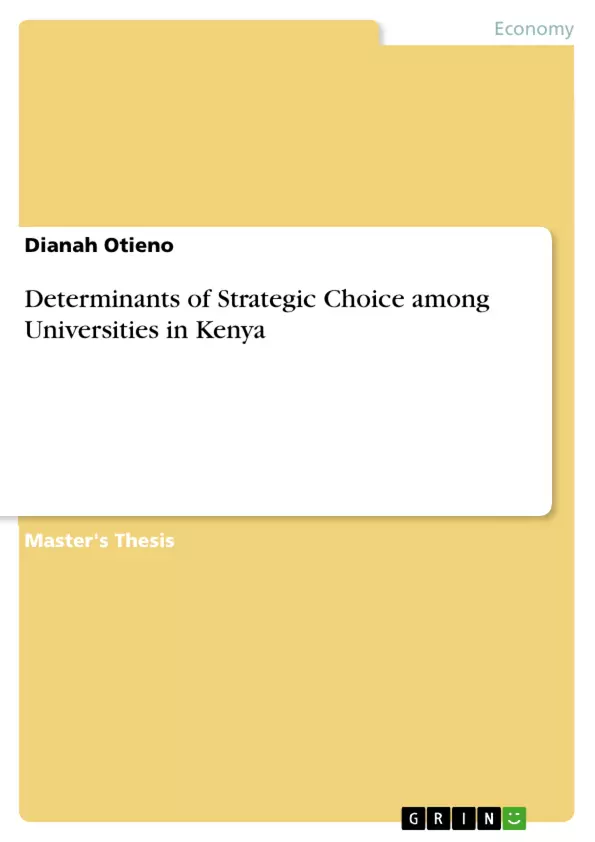Universities are considered fundamental segment of the education sector that has been sensitive to external and internal environmental changes. It is evident that the universities in Kenya are operating in a different environment than they did since their inception and face the challenge of choosing which strategy to adopt to cope with this fast paced scenario. The choices made therefore will determine their success or failure. The objective of this study was to identify the determinants of strategic choice among universities in Kenya. This study was guided by contingency and resource dependency theories and reviewed past studies on the topic to identify a knowledge gap. The study employed a cross-sectional survey research design. The target population was the 71 universities in Kenya according to the Commission for University Education. To avoid one person bias, the university registrars and heads of department were identified as the key respondents. The study used primary data which was collected using a structured questionnaire that was either hand delivered or sent online to respondents. A pilot study to pretest and validate the questionnaire was done using 7 universities which represented 10% of the 71 universities in Kenya. The Cronbach’s Alpha Co-efficient was computed for the Likert questions which were deemed reliable because they scored reliability coefficient above 0.7. The content validity was tested through expert opinion. The quantitative data collected was cleaned, coded and analyzed using Statistical Package for Social Scientists (SPSS) Software Version 20. The results were summarized into percentages and tables. The findings of the study indicate that only organization culture and vision and mission are statistically significant to strategic choice. It also pointed out that resource allocation, organization culture, competitive environment and vision and mission have an explanatory power in explaining strategic choice. The findings also revealed that universities in Kenya adopt a clan culture. In light of the findings the study recommends that universities in Kenya should have and follow defined procedures for strategic choice process and employees within these institutions should be involved in the process to create a sense of purpose.
Table of Contents
- CHAPTER ONE: INTRODUCTION
- 1.1 Background to the Study
- 1.1.1 Strategic Choice
- 1.1.2 Universities in Kenya
- 1.2 Research Problem
- 1.3 Research Objective
- 1.4 Value of the Study
- CHAPTER TWO: LITERATURE REVIEW
- 2.1 Introduction
- 2.2 Theoretical foundation of the study
- 2.2.1 Contingency Theory
- 2.2.2 Resource Dependency Theory
- 2.3 Determinants of Strategic Choice
- 2.3.1 Resources Allocation
- 2.3.2 Organization Culture
- 2.3.3 Competitive Environment
Objectives and Key Themes
The study aims to identify the determinants of strategic choice among universities in Kenya. It seeks to understand the factors influencing these institutions in their strategic decision-making processes, particularly in the context of a rapidly changing environment. The study is guided by contingency and resource dependency theories, analyzing existing literature to identify knowledge gaps.
- Influence of resources allocation on strategic choice
- Impact of organization culture on strategic decision-making
- Role of the competitive environment in shaping strategic choices
- Significance of vision and mission in driving strategic direction
- Analysis of strategic choice process and the involvement of employees within Kenyan universities
Chapter Summaries
Chapter one provides the background to the study, introducing the concept of strategic choice and the context of Kenyan universities. It outlines the research problem, objectives, and the value of the study. Chapter two delves into the theoretical framework, exploring contingency and resource dependency theories, and examining the determinants of strategic choice, including resource allocation, organization culture, and competitive environment.
Keywords
Strategic choice, universities in Kenya, contingency theory, resource dependency theory, resource allocation, organization culture, competitive environment, vision and mission, strategic decision-making, higher education, Kenyan education sector, research methodology, cross-sectional survey, quantitative data analysis, statistical significance.
- Citation du texte
- Dianah Otieno (Auteur), 2017, Determinants of Strategic Choice among Universities in Kenya, Munich, GRIN Verlag, https://www.grin.com/document/419811



